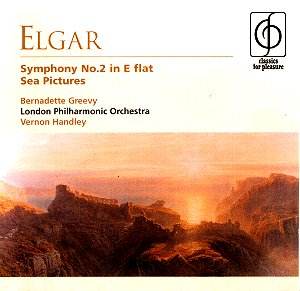This is a glorious recording in many ways. Greevy is
in wonderful voice, no mezzo-soprano in the mould of Janet Baker but
a true contralto (but again no Clara Butt, for whom the song cycle was
written). Hers is a warm, creamy-toned voice, close-miked with the LPO
hanging on every word and accompanying most sensitively. Handley takes
slow tempi for ‘Sea Slumber Song’ and ‘In Haven’, the others are more
traditional. String style is distinctly Elgarian, some may say old-fashioned,
and he has obviously encouraged Greevy to use much expressive portamento
at every opportunity. Only occasionally does the top of her voice get
pushed (especially on ‘e’ vowels) by the luscious and blazing textures
of the orchestra at forgivable climaxes, such as at the end of ‘Sabbath
Morning at Sea’. There are times where Handley has too tight a hand
on the rein in ‘Where corals lie’ and it begins to plod in places, but
‘The Swimmer’ more than makes up for it in terms of tempi and glorious
climaxes.
In this last song Handley uses the optional organ part
written by Elgar (recorded separately by David Bell in St Augustine’s
Church, Kilburn and dubbed in afterwards), and he has the chance to
repeat the exercise where the composer was alleged by Boult to have
done the same in the finale of the second symphony which makes up the
rest of this fine disc. There is no indication in the score but Boult
said (in 1947 to an audience at the Royal College of Organists, and
something that they would have loved to hear) that Elgar ‘would add
32 or 64 foot organ pedal for eight bars if it was available’. It may
be there but it is not that obvious. What is more to the point is Handley’s
literal interpretation of the tempo marking for this finale, at moderato
e maestoso it is always hard to bring off, and most conductors do
not have the courage or the ability to sustain the very steady tempo.
It works here, and does so after three movements that certainly do not
hang around in terms of their tempi, even the solemnly lugubrious funeral
march which allegedly represents the passing of the Edwardian era after
the death of the King in 1911. This disc has sustained the passing of
time, two decades ago it was acclaimed and can still be judged in glowing
terms.
Christopher Fifield
See
other Handley Classics for Pleasure releases


